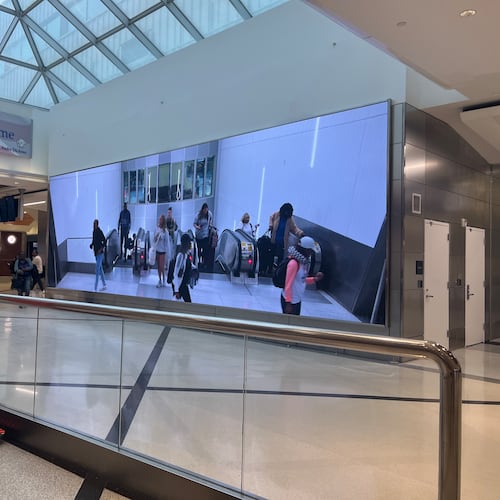Two Delta Air Lines flight attendants have filed a proposed class-action lawsuit alleging that wearing their uniforms causes skin rashes, headaches, fatigue and other issues.
The lawsuit against the uniform maker, Lands’ End, was filed in U.S. District Court in the Southern District of New York on Wednesday. Atlanta-based Delta is not named as a defendant in the case.
The class proposed in the suit includes the thousands of Delta flight attendants and gate agents required to wear "Passport Plum" uniforms.
The uniforms were designed by Zac Posen, and Delta CEO Ed Bastian has said the company invested roughly $20 million in the new uniforms for 64,000 workers.
Lands’ End said it does not comment on pending litigation.
Flight attendant Gwyneth Gilbert, who lives in Sandy Springs, is one of the plaintiffs and alleges in the suit that she "experienced rashes and skin irritations" from wearing the airline's "Passport Plum" uniforms, which debuted last year.
Gilbert's uniforms included two dresses, a pantsuit and a sweater set. She alleges in the lawsuit that she broke out in a rash after wearing uniform pieces including a mock turtleneck, pants and a blouse.
Delta said it doesn’t comment on pending litigation, but issued a statement on its uniforms.
“Although Delta and Lands’ End conducted in-depth testing during every step of development, a small number of employees have reported skin irritations,” Delta said in a written statement. “While less than one percent of employees in the new uniform program have reported issues, Delta takes this very seriously and is working directly with employees on solutions that meet their individual needs.”
Gilbert said Lands’ End sent her a replacement shirt that was “allegedly ‘untreated,’” but it made her skin “feel as though she had experienced a burn.” The uniforms are treated with chemicals for anti-wrinkle and stain-release properties.
Gilbert filed a workers’ compensation claim in January, and a dermatologist determined she is allergic to dyes and formaldehyde in the uniform, according to the complaint.
The lawsuit says Gilbert was placed on short-term disability leave from Delta from March 5 until April 2. She returned to work April 3, the suit says, and is now allowed to wear a black pantsuit and white blouse, which have not caused any physical symptoms.
The other plaintiff in the lawsuit, Monica DeCrescentis, is a Delta flight attendant in New York who alleges in the litigation that she experienced skin reactions, headaches and a low white cell blood count over the past year that she has been wearing the uniform. She also alleged that the dye in the clothing transferred onto her body, sheets, towels and other items.
DeCrescentis filed a workers’ compensation claim this month and was allegedly told that “only a ‘very limited supply’ of untreated uniforms would be released.” She is still required to wear the uniform for the job.
Delta has been requiring employees to get verification from a doctor of what they are allergic to and to try alternatives like cotton, non-wool and lined pieces before granting approval to wear black and white clothing of their choice.
The airline said it plans to soon offer a new untreated uniform option, which will also require medical documentation when it is available in June.
The lawsuit alleges negligence, design defect, manufacturing defect, failure to warn and other claims, and is seeking certification of a class for a class action, damages, an injunction and attorneys’ fees.
Flight attendants' complaints about the uniforms are among the issues being pursued by a union seeking to organize workers at Delta.
“As Delta flight attendants are non-union, at-will employees, many are reluctant to complain about the problems with their uniforms and suffer in silence, and other flight attendants wear undergarments or long underwear to protect themselves from new uniforms,” the lawsuit says.
The International Association of Machinists union in March filed a request with the National Institute of Occupational Safety and Health (NIOSH), part of the Centers for Disease Control and Prevention, for a Health Hazard Evaluation of the Delta uniforms.
NIOSH said this month it was in the beginning stages of collecting information for the Health Hazard Evaluation.
Delta employees have raised concerns about skin sensitivity to the new uniforms since shortly after they debuted a year ago.
A week after Delta rolled out the new uniforms, Delta said it had received about 25 reports of chafing and irritation.
The issues arose in spite of the company taking three years to develop the new uniform collection, test it with 1,000 employees and make adjustments before the debut.
Delta said in developing the uniforms, it worked with an auditor to visit supplier manufacturing facilities and fabric mills, conducted wear testing, allergen testing and dye testing, and developed options including the 100% cotton and non-wool uniform pieces. Yet issues still cropped up after the rollout.
About the Author
The Latest
Featured







